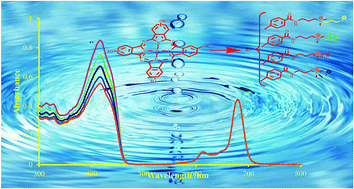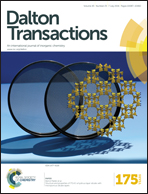Investigation of the photophysical and photochemical properties of peripherally tetra-substituted water-soluble zwitterionic and cationic zinc(ii) phthalocyanines†
Abstract
In this study, 4-{4-[N-((3-dimethylamino)propyl)amide]phenoxy}phthalonitrile (1) and its zinc(II) phthalocyanine derivative (2) were synthesized for the first time. 4-(N-((3-Dimethylamino)propyl)amide)phenoxy substituted zinc(II) phthalocyanine (2) was converted to its water-soluble sulfobetaine (3), betaine (4) and N-oxide (5) containing zwitterionic and quaternized cationic (6) derivatives. All newly synthesized compounds (1–6) were characterized by the combination of UV-vis, FT-IR, 1H NMR, mass spectroscopy techniques and elemental analysis. The photophysical (fluorescence quantum yields and lifetimes) and photochemical (singlet oxygen quantum yields) properties were investigated in DMSO for all the synthesized zinc(II) phthalocyanines (2–6) and in both DMSO and aqueous solutions for zwitterionic and cationic phthalocyanines (3–6) for the specification of their capability as photosensitizers in photodynamic therapy (PDT). The binding behavior of water soluble phthalocyanines (3–6) to the bovine serum albumin protein was also examined for the determination of their transportation ability in the blood stream.


 Please wait while we load your content...
Please wait while we load your content...